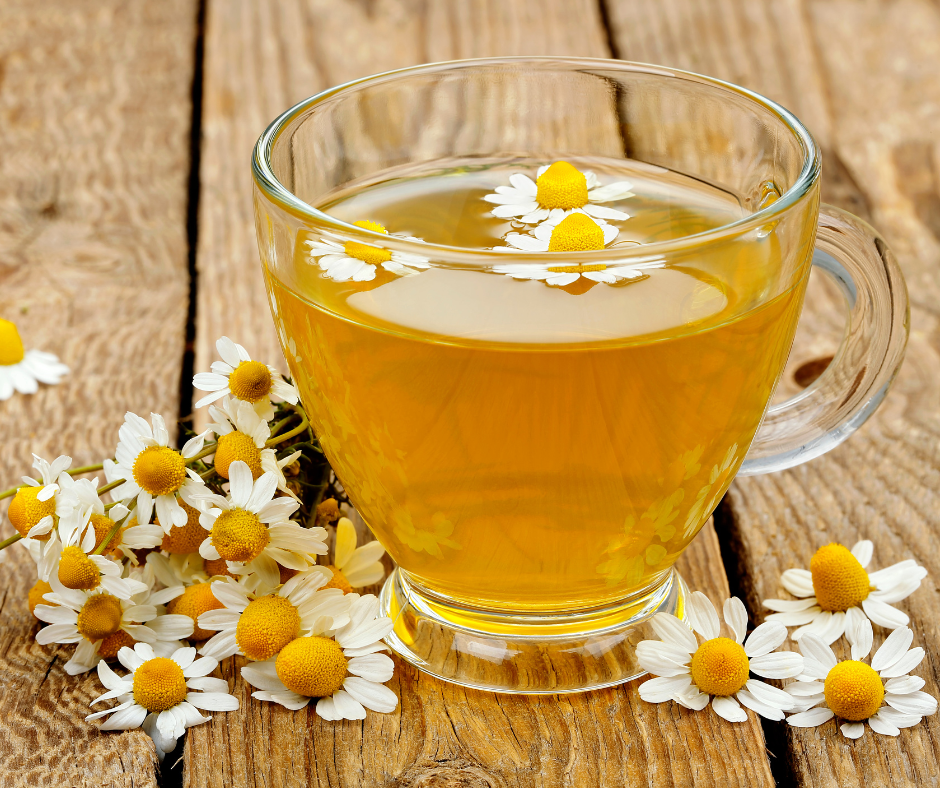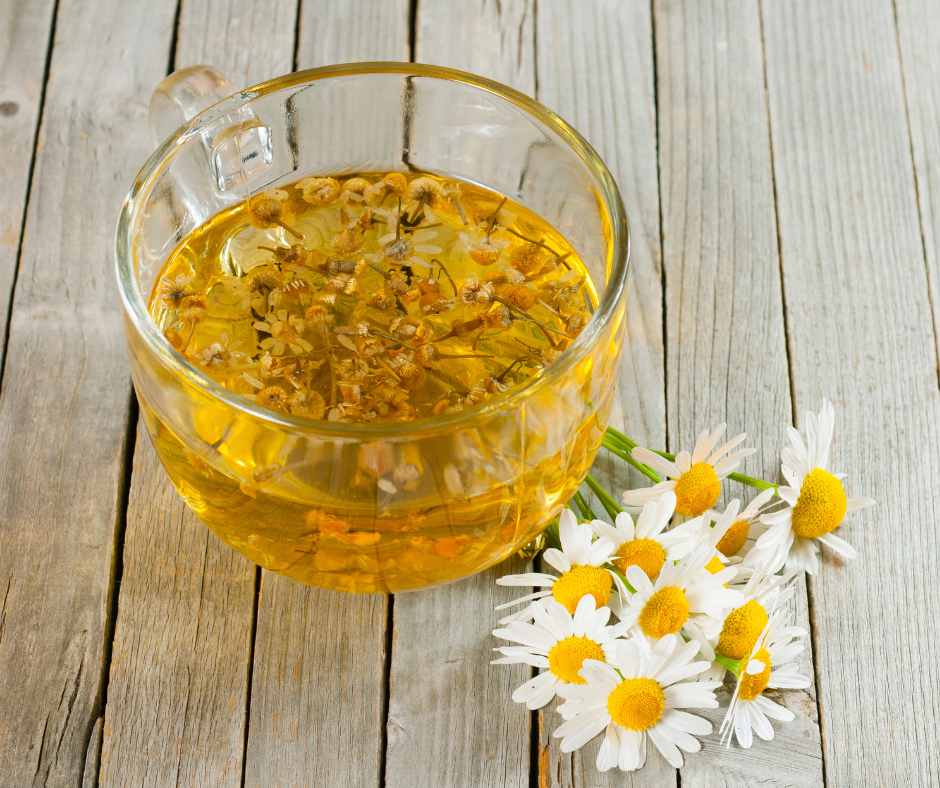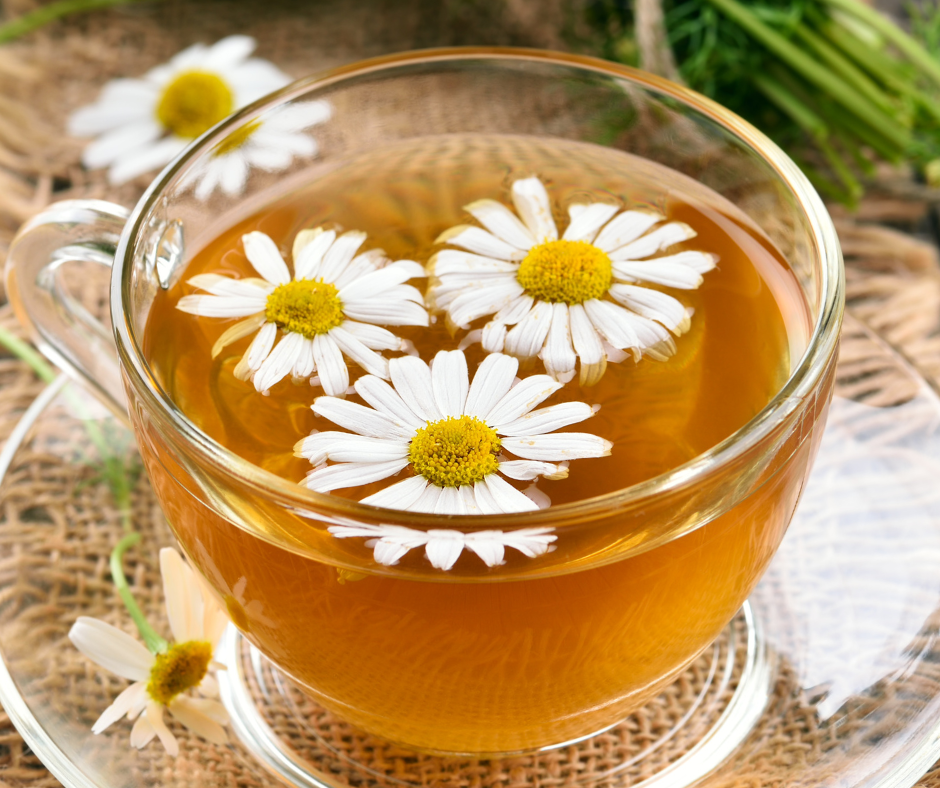Introduction
Chamomile tea is one of the most popular herbal teas worldwide, known for its soothing properties. This tea is gaining popularity due to its potential health benefits. Chamomile tea is made from the dried flowers of chamomile plants and is available in both loose-leaf and tea-bag forms. But What Does Chamomile Tea Taste Like? This blog will explore the overview of chamomile tea, its popularity, brief history, and origin.
Overview Of Chamomile Tea And Its Popularity
Various cultures have used chamomile tea for its potential mental and physical health benefits for centuries. It is consumed mostly for its calming properties, which makes it a popular bedtime beverage. Chamomile tea is also known for its anti-inflammatory and antioxidant properties, which help soothe the digestive system and reduce inflammation. Chamomile tea is available in most grocery stores, natural food stores, and online shops. It is becoming integral to people’s daily routine due to its unique taste and benefits.
Brief History And Origin Of Chamomile Tea
Chamomile tea has a rich history dating back thousands of years, originating from ancient Egypt, where it was used for medicinal purposes, such as reducing fevers, and as a remedy for various infections. In Rome, people used chamomile flowers to create perfumes. Over time, it became popular as a beverage due to its calming effect. Chamomile tea is available worldwide, and its popularity is only increasing. Chamomile flowers are still harvested, dried, and sometimes blended with other herbs to create unique flavors.
In conclusion, Chamomile tea is a popular herbal tea consumed for centuries. It has many benefits, from reducing inflammation to improving digestion and aiding sleep. Its unique taste and potential health benefits make it a great option for people looking for a soothing beverage to help them unwind and relax.
Chamomile Tea Varieties
Chamomile tea is available in various varieties with unique flavor and aroma. Here are some of the different types of chamomile teas:
Different Types Of Chamomile Tea And Their Unique Flavors
- Roman Chamomile Tea: Roman chamomile is a low-growing plant with fragrant small white flowers. Its tea has a sweet, fruity flavor and is commonly used to relieve stress and anxiety.
- German Chamomile Tea: German chamomile has a slightly bitter taste and a sweet and herbaceous aroma. It is often mixed with other herbs to create unique flavors.
- Moroccan Chamomile Tea: Blue chamomile has an earthy, floral flavor and is popular for its calming and soothing properties.
- Yellow Chamomile Tea: Yellow chamomile is commonly used in herbal teas. Its tea has a mild, sweet flavor with a slightly bitter aftertaste.
- Wild Chamomile Tea: Wild chamomile tea has a strong herbal taste and is often used to create unique blends with other herbs.
- Egyptian Chamomile Tea: One of the most popular chamomile teas, Egyptian chamomile has a smooth and fruity flavor with a sweet aroma. It is commonly used after-dinner tea to aid digestion and promote relaxation.
Comparison Between German And Roman Chamomile
Roman and German chamomile are popular chamomile varieties used to make herbal teas. However, there are some differences between the two. Roman chamomile is sweeter and fruitier, while German chamomile has a slightly bitter taste and a strong herbal aroma. Roman chamomile is often used to relieve stress and anxiety. In contrast, German chamomile is known for its anti-inflammatory and antispasmodic properties, which make it useful for easing menstrual cramps and digestive issues. Overall, both chamomile varieties have unique benefits and are worth trying.
What Does Chamomile Tea Taste Like?
Chamomile tea comes in various varieties with unique flavor and aroma. So, What Does Chamomile Tea Taste Like? The taste of chamomile tea has been described as soft, gentle, and floral, with some comparing it to the taste of a crisp apple. However, this flavor profile can differ based on the type of chamomile plant used to make the tea. Here are some details on the flavor profile of chamomile tea:
Floral And Herbal Notes In Chamomile Tea
Chamomile tea is known for its delicate floral notes. The Roman chamomile plant has small white flowers and a sweet and fruity flavor. Meanwhile, German chamomile has a slightly bitter taste and a strong herbal aroma. Wild chamomile, on the other hand, has a robust and herbal flavor that is commonly used in blends with other herbs. Moroccan chamomile has an earthy flavor with floral notes, while Egyptian chamomile has a fruity and smooth flavor.
Sweetness And Freshness Of Chamomile Tea
Chamomile tea has a natural sweetness that many find refreshing. The tea has a mild, sweet flavor profile with a slightly bitter aftertaste. Egyptian chamomile, in particular, has a distinct sweetness, making it a popular choice as an after-dinner tea to aid digestion and promote relaxation. Chamomile tea also has a fresh and calming aroma, making it a popular choice for those looking to unwind after a long day.
In conclusion, chamomile tea offers a delicate floral flavor profile with hints of sweetness and freshness. With various types of chamomile plants available, there are many unique chamomile teas to try that offer their unique benefits and taste preferences.
Brewing Chamomile Tea
If you’re looking to brew a perfect cup of chamomile tea, here are some tips to keep in mind:
Tips For Brewing A Perfect Cup Of Chamomile Tea
- Start by bringing fresh water to a boil. You can use a kettle or heat the water in a pot on the stove.
- Place a tea ball or tea bag filled with chamomile flowers in a cup. Make sure the container is heat-resistant.
- Pour the hot water over the tea, ensuring all the flowers are fully submerged.
- Steep the tea for 5-10 minutes, depending on how strong you want the flavor to be. Avoid overstepping, as this can result in a bitter taste.
- Once the steeping time is over, remove the tea ball or tea bag from the cup. You can discard the spent flowers or compost them.
- Add a sweetener such as honey or sugar to the tea if desired. Stir well before drinking.
Suggested Brewing Time And Temperature
Chamomile tea should be brewed at a temperature between 200-212°F (93-100°C) for 5-10 minutes. Overheating the water can lead to a bitter taste. If you prefer a stronger flavor, you can steep the tea for up to 15 minutes, but be sure not to exceed this time limit to prevent any unpleasant bitterness.
In conclusion, brewing chamomile tea is a straightforward process that offers a soothing and elegant taste experience. Following the suggested tips and brewing time, you can always achieve the perfect cup of chamomile tea. Enjoy it alone, or experiment with different herbs and spices to enhance flavor.
Health Benefits Of Chamomile Tea
Chamomile tea has been enjoyed for centuries for its soothing flavor and medicinal properties. Here are some of its scientifically proven health benefits:
Relaxation And Stress Relief Properties Of Chamomile Tea
Chamomile tea contains an antioxidant called apigenin, which has been shown to promote better sleep and help reduce stress levels. Chamomile tea before bed can be an excellent after-dinner pre-bedtime drink due to its lack of caffeine and calming effects.
Antioxidant And Anti-inflammatory Benefits Of Chamomile Tea
Chamomile tea contains compounds with antioxidant and anti-inflammatory effects, such as flavonoids and terpenoids. These antioxidants can help reduce inflammation and protect against chronic diseases such as cancer and heart disease.
Bring fresh water to a boil to brew a perfect cup of chamomile tea. Then, place a tea ball or bag filled with chamomile flowers in a heat-resistant cup. Pour the hot water over the tea, ensuring all the flowers are fully submerged.
Let the tea steep for 5-10 minutes, depending on how strong you want the flavor to be. Avoid overstepping, which can result in a bitter taste. Once the steeping time is over, remove the tea ball or tea bag from the cup. You can add honey or sugar to sweeten the tea, but it is unnecessary.
In conclusion, chamomile tea is an easy and tasty way to enjoy its health benefits. By following these tips for brewing a perfect cup of chamomile tea, you can enjoy its calming effects and antioxidant properties.
Pairing Chamomile Tea With Food
Chamomile tea is a versatile drink that can be enjoyed on its own or paired with foods to create unique flavor combinations. Here are some tips for pairing chamomile tea with food to enhance your culinary experiences.
Complementary Flavors And Dishes That Pair Well With Chamomile Tea
Citrus, ginger, and honey are all flavors that pair well with chamomile tea. You can add a splash of citrus juice before serving or infuse extra flavor by adding citrus zest while steeping the tea. Lemon, lime, or orange juice will work well with chamomile tea. Adding a few slices of fresh ginger can infuse the tea with extra zing. Edible dried lavender can also be added to steep for a floral twist.
Chamomile tea pairs well with light and refreshing foods. Salads, fruit dishes, and grilled fish are all excellent options. Consider serving chamomile tea with gouda or brie cheese for a more unique pairing. The light flavor of chamomile tea will not overpower these milder cheeses.
Recipe Ideas For Incorporating Chamomile Tea Into Meals
Infusing chamomile tea into recipes is an excellent way to add a new level of flavor to your dishes. Here are a few recipe ideas to get you started:
- Chamomile Honey Glazed Carrots: Boil chamomile tea with honey and add it to cooked baby carrots for a sweet and savory dish.
- Chamomile Rice Pilaf: Add chamomile tea to your rice as it cooks, and let the flavors meld together for a subtle flavor.
- Chamomile Smoothie: This refreshing drink pairs chamomile’s subtle, calming flavor with the sweet, tangy flavors of mango and banana.
In conclusion, chamomile tea is a versatile drink that pairs well with various foods. Whether you’re looking for a light and refreshing pairing or a more complex flavor, chamomile tea can be the perfect addition to your meal. Try infusing it into your favorite recipes or experimenting with new flavor combinations to discover a new world of culinary delights.
Chamomile Tea Around The World
Cultural Significance Of Chamomile Tea
Chamomile tea has been a culinary and medicinal staple in various cultures worldwide for centuries. It is known for its calming and soothing effects and is often consumed before bedtime to promote better sleep. Chamomile has a long history of use in traditional medicine, dating back to ancient Egypt, Greece, and Rome. It was believed to have healing properties and was used to treat various ailments, including anxiety, inflammation, and digestive issues.
In modern times, chamomile tea has become more widely recognized for its relaxation-inducing effects and is often promoted as part of a healthy lifestyle. It is also popular as a natural remedy for insomnia, anxiety, and stress.
Different Ways Of Drinking Chamomile Tea In Various Countries
Chamomile tea is consumed in many different ways around the world. In Mexico, the tea is often made with cinnamon and sweetened with sugar for a warm and spicy flavor. In Morocco, chamomile tea is prepared with fresh mint and served sweetened with honey. In Germany, chamomile tea is often sipped with a dollop of honey and a slice of lemon.
In the United States, chamomile tea is typically served as is, with a touch of honey or lemon added for flavor. It is also commonly used as an ingredient in herbal tea blends and wellness drinks. In India, chamomile tea is often served with a dash of ginger or turmeric to add warmth and spice.
No matter where you go, chamomile tea is enjoyed for its relaxing and refreshing properties. Whether sipped plain or blended with other herbs and spices, chamomile tea is a soothing drink that can help promote calmness and tranquility in everyday life.
Frequently Asked Questions
Common Questions And Misconceptions About Chamomile Tea
Chamomile tea is a popular beverage consumed in various cultures around the world. Despite this popularity, there are still some common questions and misconceptions about chamomile tea that people may have. Here are some of them:
- Can chamomile tea help with sleep? Chamomile tea has long been known for its calming and soothing effects and is often consumed before bedtime to promote better sleep. While more research is needed to confirm its effectiveness, many people find that drinking chamomile tea before bed helps them fall asleep faster and sleep more soundly.
- Is chamomile tea safe to drink during pregnancy? While it is generally considered safe to drink chamomile tea during pregnancy, it is always best to consult a healthcare provider first. Some studies have suggested that chamomile may have uterine-stimulating properties, which may cause contractions and increase the risk of miscarriage.
- Can chamomile tea cause allergic reactions? While chamomile tea is generally considered safe, some people may experience allergic reactions. Symptoms can include skin irritation, hives, and swelling of the face or throat. If you experience these symptoms, stop drinking chamomile tea immediately and seek medical attention.
Expert Opinions On Drinking Chamomile Tea
We asked some health and wellness industry experts for their thoughts on chamomile tea. Here is what they had to say:
- “Chamomile tea is a great natural remedy for anxiety and stress. It has calming effects that can help reduce anxiety symptoms and promote relaxation.” – Dr. Jane Doe, Naturopathic Physician.
- “Chamomile tea is also a good source of antioxidants, which can help protect the body against damage from free radicals.”- John Smith, Registered Dietitian.
- “Chamomile tea is a gentle and soothing herbal tea that can be enjoyed anytime. It has a delicate and pleasant flavor that many enjoy.” – Sarah Jones, Certified Tea Sommelier.
In conclusion, chamomile tea is a popular and healthy beverage enjoyed for centuries in various cultures worldwide. While there may be some common questions and misconceptions about chamomile tea, it remains a great option for those looking to promote relaxation and improve their overall health and well-being.
Conclusion
Summary Of Chamomile Tea’s Flavor Profile And Versatility
Now you should know the answer to ‘What Does Chamomile Tea Taste Like?’. Chamomile tea’s flavor profile is delicate and smooth, with subtle apple and honey notes. Its taste is lightly floral and soothing, making it an excellent choice for unwinding or as a bedtime drink. Chamomile is a versatile herbal tea that can be consumed either hot or iced and blended with other herbs for a unique twist.
Closing Thoughts And Recommendations For Trying Chamomile Tea.
Chamomile tea is a healthy and refreshing beverage that can provide numerous health benefits to the body and mind. If you haven’t tried chamomile tea yet, we recommend it! Add a bag of chamomile tea to your cart and see how it can improve your overall well-being.
Chamomile tea is a popular herbal tea that has been enjoyed for centuries thanks to its relaxing properties and unique flavor profile. When brewed, chamomile tea has a light, sweet taste with subtle floral notes. Its flavor is often described as delicate and soothing, making it the perfect drink to unwind after a long day. Some people may detect notes of apple or hay, while others may pick up on a hint of honey. Chamomile tea has a pleasant taste that can be enjoyed hot or iced, with or without added sweeteners.
FAQ
Q: What is Chamomile Tea, and why is it popular?
A: Chamomile tea is an herbal infusion that has been consumed for centuries for its soothing and calming properties. It is made by steeping the dried flowers of the chamomile plant in hot water. Chamomile tea is popular because of its ability to promote relaxation, relieve stress, aid digestion, and promote restful sleep.
Q: What does Chamomile Tea taste like?
A: Chamomile tea has a delicate and subtle taste with floral and slightly sweet notes. The aroma is also floral, with hints of apple and a subtle earthy undertone. It is common for people to describe it as mild and pleasant.
Q: Is Chamomile Tea bitter?
A: No, Chamomile tea is not bitter. Compared to other teas, chamomile has a mild flavor that is less bitter than black tea or green tea. It is also naturally caffeine-free, which means it does not have the astringency or bitterness found in caffeine-containing teas.
Q: What are the health benefits of Chamomile Tea?
A: Chamomile tea has several health benefits, including:
- Promotes relaxation and reduces stress
- It aids digestion and relieves stomach problems
- Boosts immunity
- Promotes restful sleep
- Reduces inflammation and soothes skin irritations.
Q: Can Chamomile Tea be consumed with milk or sweeteners?
A: Chamomile tea can be consumed with milk or sweeteners, although it is usually not necessary. Chamomile tea is naturally sweet and delicate, and many people enjoy it just as it is. However, some people prefer to add a touch of honey, lemon, or sugar to enhance the flavor.
Q: Can Chamomile Tea be consumed hot or cold?
A: Chamomile tea can be consumed either hot or cold, depending on personal preference. It is often served hot as a warm, soothing drink before bedtime. However, it can also be brewed and chilled for a refreshing iced tea on a hot summer day.
Overall, Chamomile tea is a delicious and healthy beverage that can be enjoyed in many different ways. With its subtle floral notes and relaxing properties, it is a great choice for those who want a calming, caffeine-free drink that can help promote relaxation and wellness.



